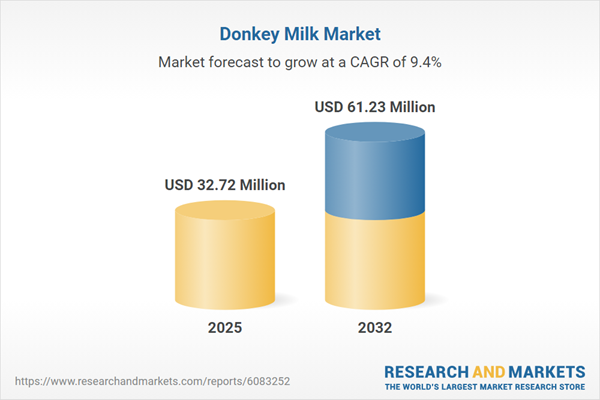Speak directly to the analyst to clarify any post sales queries you may have.
The donkey milk market is rapidly evolving, fueled by rising demand for natural, functional ingredients across both nutrition and personal care sectors. Adaptation to changing consumer values, a focus on transparency, and the adoption of regional approaches are shaping a competitive landscape where informed, agile strategies are essential.
Market Snapshot: Donkey Milk Market Size and Growth Overview
In 2024, the Donkey Milk Market was valued at USD 29.92 million, expanding to USD 32.72 million in 2025 and projected to achieve a compound annual growth rate (CAGR) of 9.36%. The market is expected to reach USD 61.23 million by 2032. This consistent upward growth reflects shifting consumer choices toward products that offer natural origins, minimal processing, and functional benefits. Donkey milk’s profile—spanning both nutritional and skincare attributes—positions it at the intersection of the wellness trend and modern clean-label standards, supporting product development strategies focused on authenticity and consumer trust.
Scope & Segmentation: Strategic Dimensions Driving Innovation
This report provides senior executives with a detailed segmentation of the donkey milk market across all key drivers, enabling targeted strategy formulation and risk management:
- Applications: Bath products, hair care, infant formula, nutritional drinks, body care, and facial care—demonstrating increased inclusion of donkey milk within holistic wellness and daily care routines.
- Product Types: Lyophilized, powdered, and raw formulations—ensuring flexibility in product processing, stability, and the ability to retain key bioactive ingredients across sectors.
- Distribution Channels: Online platforms, specialty stores, supermarkets, and hypermarkets—capturing the spectrum of evolving procurement behaviors and optimizing channel strategies.
- End User Profiles: Segmentation by adults, elderly, and infants—meeting tailored nutritional requirements and evolving consumer attitudes in specialized nutrition and care markets.
- Regional Scope: Detailed analysis of the Americas, Europe, Middle East & Africa, and Asia-Pacific—accounting for cultural drivers, raw material sourcing dynamics, and distinct regulatory standards that influence commercial opportunity.
- Leading Companies: Key industry entities, such as Laboratoires Bio Secrets SAS, Savonnerie du Midi Ateliers de Régence SAS, Hippodamia S.p.A., Ferme des Gabbas SAS, Farma di Natura S.r.l., Mühlehof AG, Equus Naturals Inc., and Anera Naturals GmbH—mapping the competitive landscape and spotlighting innovation and partnership opportunities across the value chain.
Key Takeaways: Strategic Insights for Senior Decision-Makers
- Increasing preference for clean-label, naturally sourced ingredients positions donkey milk as a central component in product portfolios for wellness, personal care, and specialty nutrition brands.
- Adoption of microfiltration and advanced traceability tools is improving transparency, product integrity, and trust in both sourcing and finished goods.
- Refinements in animal husbandry practices alongside contemporary freeze-drying techniques support reliability and preserve the active composition of donkey milk, reinforcing premiumization strategies.
- Brand strategies increasingly leverage donkey milk in both topical skincare products for sensitive users and easily digestible nutrition solutions, supporting cross-category expansion and enhanced brand value.
- Regional market adoption varies, with the Americas capitalizing on established logistics, Europe and the Middle East leveraging tradition and regulation, and Asia-Pacific driving rapid growth through agile innovation.
- Collaboration between academia, suppliers, and entrepreneurial brands accelerates product development cycles and broadens market reach, supporting differentiation and strategic value creation.
Tariff Impact: Shifts and Industry Reactions
Recent U.S. tariff policy changes have led to recalibration of cost structures, motivating local producers to increase investment in domestic breeding and supply chain diversification. This industry response is fostering stronger local partnerships, enhanced quality control practices, and a reduced reliance on imports, enabling agility amid ongoing market fluctuations.
Methodology & Data Sources
This analysis synthesizes insights from executive-level interviews with producers, subject matter experts, and distribution partners with targeted secondary research from scientific publications and regulatory bodies. Rigorous triangulation and peer review ensure the highest degree of reliability and strategic value for actionable business intelligence.
Donkey Milk Market: Why This Report Matters
- Guides senior leaders through robust segmentation and trend analysis, informing both regional and multi-channel expansion planning.
- Supports evidence-based investment decisions by identifying modernization in supply chains, evolving distribution models, and emerging regulatory demands.
- Arms decision-makers with forward-looking perspectives on shifting consumer attitudes, industry adaptation, and market-entry strategies for efficient risk management.
Conclusion
Combining heritage with technological progress, the global donkey milk industry is experiencing significant transformation. Executives who leverage the insights from this report will be well-positioned to optimize decision-making and pursue sustainable growth in a dynamic, innovation-driven market.
Table of Contents
3. Executive Summary
4. Market Overview
7. Cumulative Impact of Artificial Intelligence 2025
Companies Mentioned
The companies profiled in this Donkey Milk market report include:- Laboratoires Bio Secrets SAS
- Savonnerie du Midi Ateliers de Régence SAS
- Hippodamia S.p.A.
- Ferme des Gabbas SAS
- Farma di Natura S.r.l.
- Mühlehof AG
- Equus Naturals Inc.
- Anera Naturals GmbH
Table Information
| Report Attribute | Details |
|---|---|
| No. of Pages | 180 |
| Published | October 2025 |
| Forecast Period | 2025 - 2032 |
| Estimated Market Value ( USD | $ 32.72 Million |
| Forecasted Market Value ( USD | $ 61.23 Million |
| Compound Annual Growth Rate | 9.3% |
| Regions Covered | Global |
| No. of Companies Mentioned | 9 |









